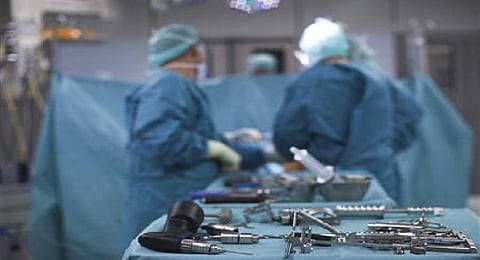

CHENNAI: A 15-year-old patient diagnosed with 'Anaconda spine', which is a rare condition of spine that affects the ability to walk, was successfully treated for the disorder at a private hospital in the city recently.
Kyphoscoliosis, which in a spine surgery circle called ‘Anaconda Spine’, is a deformity of the upper spine in the chest area. The deformity severely affects the patient's ability to walk. The surgery was conducted at SIMS Hospital by Dr K Appaji Krishnan, Senior Consultant Spine Surgeon, Asian Orthopaedic Institute.
Doctors say that the patient was suffering from Neurofibromatosis, a genetic condition which causes deformity in the spine. Mersha was a normal boy 6 years ago, when his parents started noticing a deformity in the upper back. The deformity progressed to this severity over time.
He was brought to SIMS Hospital in the month of May with a unique condition of Kyphoscoliosis- a 110 degrees curve in the spine shaped like an Anaconda. The curved spine was obstructing the expansion of the lungs and making a back pressure to the heart.
Recognising the severity of the condition, the team immediately developed a specific treatment protocol. It was decided to treat the patient with a halo gravity traction by hanging 13-14kg of weight to the patients head for a continual 4 weeks time period to stretch the Anaconda spine and straighten the deformity.
Commenting on the surgery, Dr. K Appaji Krishnan, Senior Consultant Spine Surgeon, Asian Orthopaedic Institute, SIMS Hospital said, "Depending on the severity of the deformity his surgery to straighten the spine was done after careful observation and traction for 4 weeks. The disease which could cause heart and lung failure, was successfully treated and the patient is all better and in a good condition now. We are truly happy to have played a role in making his dream of playing football.”
Post the treatment, a high-performance surgery was performed in assistance from the well trained Anesthesia team and an in-house Intraoperative Neuromonitoring expert. The procedure was facilitated by a pre-operative model of the spine which was prepared by in-house 3D printing technology. A 15-year-old patient diagnosed with 'Anaconda spine', which is a rare condition of spine that affects the ability to walk, was successfully treated for the disorder at a private hospital in the city recently.
Kyphoscoliosis, which in a spine surgery circle called ‘Anaconda Spine’, is a deformity of the upper spine in the chest area. The deformity severely affects the patient's ability to walk. The surgery was conducted at SIMS Hospital by Dr K Appaji Krishnan, Senior Consultant Spine Surgeon, Asian Orthopaedic Institute.
Doctors say that the patient was suffering from Neurofibromatosis, a genetic condition which causes deformity in the spine. Mersha was a normal boy 6 years ago, when his parents started noticing a deformity in the upper back. The deformity progressed to this severity over time.
He was brought to SIMS Hospital in the month of May with a unique condition of Kyphoscoliosis- a 110 degrees curve in the spine shaped like an Anaconda. The curved spine was obstructing the expansion of the lungs and making a back pressure to the heart.
Recognising the severity of the condition, the team immediately developed a specific treatment protocol. It was decided to treat the patient with a halo gravity traction by hanging 13-14kg of weight to the patients head for a continual 4 weeks time period to stretch the Anaconda spine and straighten the deformity.
Commenting on the surgery, Dr. K Appaji Krishnan, Senior Consultant Spine Surgeon, Asian Orthopaedic Institute, SIMS Hospital said, "Depending on the severity of the deformity his surgery to straighten the spine was done after careful observation and traction for 4 weeks. The disease which could cause heart and lung failure, was successfully treated and the patient is all better and in a good condition now. We are truly happy to have played a role in making his dream of playing football.”
Post the treatment, a high-performance surgery was performed in assistance from the well trained Anesthesia team and an in-house Intraoperative Neuromonitoring expert. The procedure was facilitated by a pre-operative model of the spine which was prepared by in-house 3D printing technology.
Visit news.dtnext.in to explore our interactive epaper!
Download the DT Next app for more exciting features!
Click here for iOS
Click here for Android